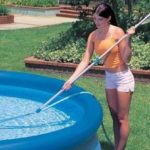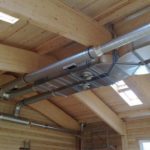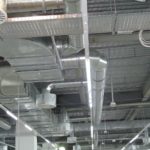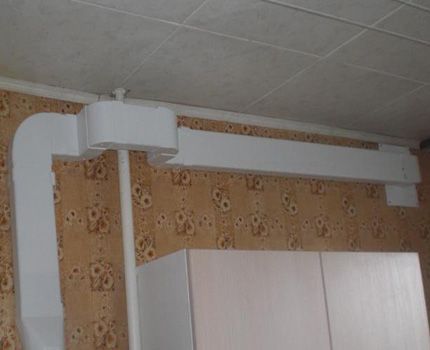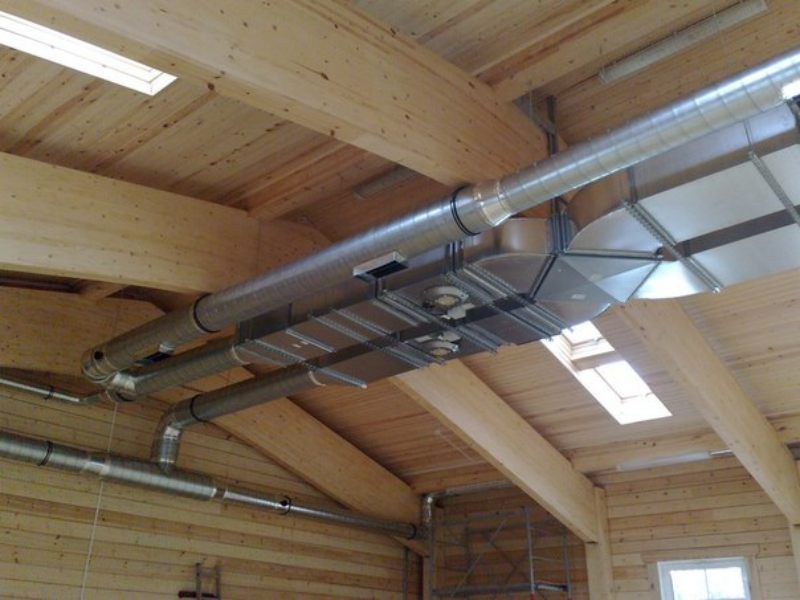Pool ventilation
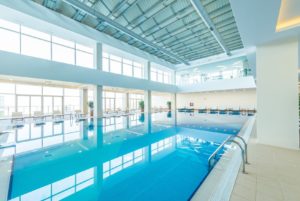 First of all, when building a pool, care must be taken to create the proper microclimate, because water continuously evaporates from its surface, droplets of which settle on the ceiling and walls. High humidity not only creates a favorable environment for pathogens of fungi and mold, but also has a detrimental effect on electronic equipment, decoration and walls of the building. All these problems can be solved by installing ventilation in the pool.
First of all, when building a pool, care must be taken to create the proper microclimate, because water continuously evaporates from its surface, droplets of which settle on the ceiling and walls. High humidity not only creates a favorable environment for pathogens of fungi and mold, but also has a detrimental effect on electronic equipment, decoration and walls of the building. All these problems can be solved by installing ventilation in the pool.
The content of the article
- Ventilation options
- Pool ventilation project for a private house
- Carrying out the necessary calculations
- Microclimate control and regulation
- How to create ventilation with your own hands in a private house with a swimming pool
- Tools and materials required for installation of ventilation
- Process Description of Swimming Pool Ventilation Unit
Ventilation options
There are many ventilation systems, but the two most often used are:
- supply;
- supply and exhaust.
Option I
This type is classified as separate, when the inflow and outflow of air is carried out by separate elements of the system. Equipment for such an installation is cheaper, although it will require significant expenses during operation, and its considerable dimensions are not suitable for small rooms.
A separate supply of fresh air from the outlet of humidified air is a distinctive feature of supply ventilation.
Installation of such systems is carried out at the time of construction of the pool, when its main element, the fan, is installed in the exhaust ducts.
The flow of fresh air is realized using devices such as:
- control unit responsible for temperature conditions and maintaining the required air volume;
- an air intake device with a valve that will prevent cold air from entering the room when the system is turned off;
- a fan that pumps it;
- filter for cleaning;
- a device for heating incoming air.
Option II
Such a system operates in a single block. Purchasing the necessary equipment will require significant expenses, but during operation it is much more economical than the first option.
Main advantages:
- Does not require much space for installation.
- Thanks to the presence of a recuperator, electricity consumption is insignificant, since the incoming air is heated by the exhaust gas, but at the same time is not combined with it. This saves up to 50% of electricity. Thanks to the thermal reserve, we have a constant temperature in the room.
The design of such a system includes a number of important elements:
- supply air heater;
- recuperator;
- supply and exhaust fan;
- filter for cleaning;
- double valve that prevents the supply of cold air when the system is turned off.
Such ventilation systems can additionally be equipped with dehumidifiers and devices for distributing warm air to other rooms.
Pool ventilation project for a private house
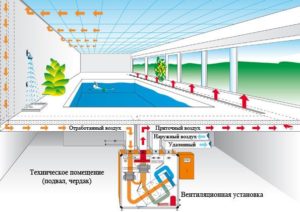 Indoor swimming pools in low-rise housing construction are becoming increasingly popular. Usually the first floor is used for its construction.The preferred water surface area is from 18 to 50², and the depth is up to 2 m. Paths and recreation areas are located around the perimeter. The main requirement for a private pool project is reliability and comfort.
Indoor swimming pools in low-rise housing construction are becoming increasingly popular. Usually the first floor is used for its construction.The preferred water surface area is from 18 to 50², and the depth is up to 2 m. Paths and recreation areas are located around the perimeter. The main requirement for a private pool project is reliability and comfort.
A pool of this size is designed for 2-5 people. It can be used all year round or seasonally.
Basic Rules
The operating parameters that are recommended for a private swimming pool are as follows:
- t water 26-29 °C;
- air temperature 27-32 °C;
- relative humidity in summer is 65%, and in winter - 50;
- air mobility is approximately 0.2 m/s.
To prevent air stagnation in the room, the power of the exhaust equipment should be higher than the same parameter of the supply units by half the factor.
Design Features
The development of an individual project for a swimming pool of a private house is carried out taking into account SNiP 2.08.02–89 SP and is carried out in the following order:
- Calculation of heat losses and moisture intake is carried out.
- A ventilation scheme and drying device are selected.
- The estimated air exchange is calculated.
- The length of air ducts is calculated, and the placement of exhaust and flow chambers is carried out.
- Determine pressure losses in all elements of the ventilation system and its throughput.
- Drawings are drawn up and specifications are drawn up.
After taking into account all these parameters, equipment of the required power is selected.
Carrying out the necessary calculations
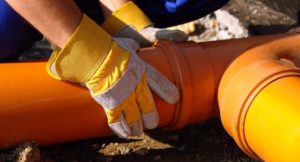 To carry out the calculations, you will need data such as the volume of the room and liquid in the tank, the surface area where water and air come into contact, the size of the bypass paths, temperature indicators and the number of visitors.
To carry out the calculations, you will need data such as the volume of the room and liquid in the tank, the surface area where water and air come into contact, the size of the bypass paths, temperature indicators and the number of visitors.
Based on the difference between the product of the pool surface area and the vapor pressure in saturated air and the evaporation coefficient, the air exchange is calculated. The value of the coefficient is taken from tables that take into account all indicators that affect the degree of operation of the room, and the number of procedures that increase air humidity.
Microclimate control and regulation
There are three methods by which you can control humidity:
- Condensation. When air flow is forced through the dehumidifier.
- Moisture assimilation. This method purifies the air from persistent foreign odors.
- The most effective is a combined method, in which the dehumidifier and ventilation work independently or in concert, thereby maintaining an optimal microclimate.
Before choosing one method or another, you need to know the amount of moisture that will evaporate from the water surface over a certain period of time.
How to create ventilation with your own hands in a private house with a swimming pool
 If you decide to install ventilation yourself, then you need to follow a number of rules:
If you decide to install ventilation yourself, then you need to follow a number of rules:
- Hoods should be placed on the wall near the ceiling, since warm air moves from bottom to top.
- To ensure sufficient air speed, it is better to use ventilation grilles with a maximum area.
- The inflow is installed in the opposite part of the room from below.
The main thing is to remember! Only ventilation designed in accordance with the rules will protect you from health problems and significant energy costs.
Tools and materials required for installation of ventilation
- The installation of ventilation in the pool is carried out using the same technology as conventional installation.
- Preference is given to air ducts with a circular cross-section.
- Air ducts made of stainless steel or plastic on the exhaust line.
- The air duct through which cold air is taken in must be insulated. Thermal insulation thickness is at least 50 ml.
It is recommended to install noise suppressors and vibration supports at the fan outputs, and use fans with speed controllers. Compliance with these rules and the use of soundproofing materials will make visiting the pool more comfortable.
Process Description of Swimming Pool Ventilation Unit
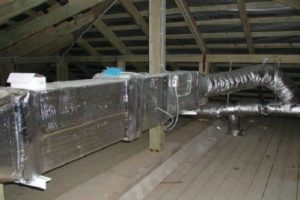 Pool ventilation is designed to eliminate excess moisture, supply fresh air, and create comfortable conditions. Let's consider this process using the example of supply and exhaust ventilation. At the highest point of the room, moist and hot air is taken in, then it passes through a system of filters that purify it. Here, chemical filters retain chlorine vapors.
Pool ventilation is designed to eliminate excess moisture, supply fresh air, and create comfortable conditions. Let's consider this process using the example of supply and exhaust ventilation. At the highest point of the room, moist and hot air is taken in, then it passes through a system of filters that purify it. Here, chemical filters retain chlorine vapors.
After this, the taken air is supplemented with fresh air in the required volume. This air mixture is driven through the radiators of the dryer and heater, thereby bringing it to the required temperature and removing excess moisture. Then the resulting air mass is returned to the room.
Ventilation in a private pool is not a simple system, so its arrangement is best left to specialists.

